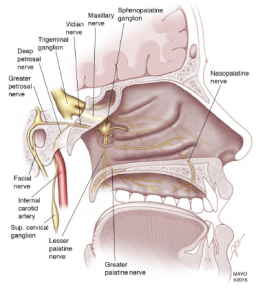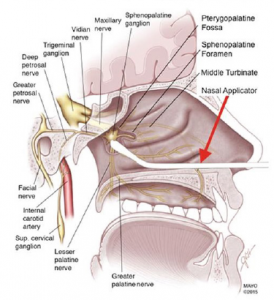How Long Does A Spg Block Last

Effigy 1: The SPG is associated with the trigeminal nerve, the major nervus involved in headache disorders. It is an extracranial parasympathetic ganglion located behind the nasal bony structures. It has ii ganglia, one in each of the bilateral fossae located posterior to the middle turbinate. Information technology is made up of three fretfulness, the sensory, sympathetic, and parasympathetic.
Illustration: Headache. 2016;56:240-258.
The sphenopalatine ganglion (SPG) is associated with the trigeminal nerve, the major nerve involved in headache (HA) disorders (see Figure i).i The machinery backside migraines is not fully understood, just it'south thought that blocking the SPG may help relieve migraine hurting.i,2
The SPG is the main source of cranial and facial parasympathetic innervation. The autonomic fretfulness of the SPG supply the lacrimal glands, which produce tears, as well equally the sinuses, which tin can produce the nasal discharge or congestion associated with some migraines.two-4
SPG's Function in Headaches
When a headache occurs, meninges inflammation activates pain receptors. These receptors send hurting impulses through the trigeminal nerve, which then sends a signal to the brain that is perceived as hurting. In cluster and migraine HA, pain signals pass through the SPG, connecting with autonomic nerves, which produce eye tearing or nasal discharge. This is called the trigeminal autonomic reflex.3,4
During a migraine, parasympathetic outflow from the SPG causes vasodilation of cranial blood vessels. This dilation allows for inflammatory mediators to activate meningeal nociceptors, which are responsible for the migraine pain. It'due south theorized that a patient who experiences parasympathetic symptoms during migraines (eg, nausea, emesis, sweating, lacrimation, etc.) may benefit from SPG blocking because the SPG propagates these parasympathetic signals.three,four

Figure 2: The cotton fiber-tip applicator should contact the mucosa overlying the SPG.
Analogy: Anesthesiology. 2018;128(1):140.
A prospective, randomized and double-blinded placebo-controlled study published in JAMA in 1996 showed potential benefit for using intranasal lidocaine when compared with saline alone.5 The written report included a total of 81 patients with a primary complaint of headache who fulfilled criteria for International Headache Society. The primary outcome measure establish at least a 50 percent reduction of headache inside fifteen minutes of treatment. Fifty-five pct of patients had at to the lowest degree a 50 percent reduction of headache compared with 21 percent of patients in the control grouping, and nausea and photophobia were significantly reduced. Rescue medication for headache relief was needed in 28 percent of patients in the lidocaine group versus 71 percent of patients in the command group. Of those patients who showed initial improvement, but 42 percent relapsed versus 83 percent in the control group.
How to Perform an SPG Nerve Block
The SPG can be locally accessed past several approaches, but for the purposes of quick and easy admission in the ED setting, the transnasal arroyo is best.3 The materials needed include:
- Cotton-tip applicator, 10 cm long
- Anesthetic of your pick:
- Lidocaine 1%, ii%, or 4% (onset 15 minutes, duration of action 30 minutes to 2 hours)vi
- Bupivacaine 0.25% or 0.v% (onset 10–twenty minutes, duration of activity 2–4 hours)six
- 5 mL syringe and large bore needle to draw up the coldhearted
- Plastic pill cup or whatsoever small container that can hold the anesthetic with plenty depth to fully submerge the cotton wool-tip applicator
- Atomizer (optional).
The technique:
- Have the patient prevarication in a supine position with the head tilted up in a sniffing position.
- Make sure the patient is on a cardiac monitor. Fifty-fifty though you are using less than the toxic dose, you are administering anesthetic over a highly vascular area.
- Hypnotize the nasal passage entry by one of two ways (optional):
- Inject 0.v mL of 2% viscous lidocaine into each nostril with the open end of a three mL syringe (without needle). Have the patient sniff to draw the anesthetic posteriorly.
- Use an atomizer to draw up i mL of 1% lidocaine per naris and aerosolize into each naris. Think, y'all tin can administrate a maximum of i mL per naris.
- Soak one or two cotton fiber-tip applicators in the anesthetic of your choice. If you are pre-anesthetizing the nasal passage, we recommend using merely 1% or 2% lidocaine to soak the applicators, the goal beingness to remain well below the toxic dose.
- Accelerate one cotton-tip applicator along the superior border of the middle turbinate of each nostril until the tip contacts the mucosa overlying the SPG (encounter Effigy 2).
- Go out the applicators in for x minutes or until the patient feels relief, then gently remove the applicators.3,seven
Make sure you inform patients of the possible side effects so they know what to look, including:
- Bitter sense of taste from the anesthetic
- Nausea
- Local trauma causing epistaxis
- Light-headedness
- Numbness in the posterior throat4
Final Points
SPG nerve blocks are a quick and not-invasive way to treat primary headaches that do not crave Four placement. Such blocks may be a good choice for patients who feature difficult Iv access.three
Source: https://www.acepnow.com/article/migraine-care-why-and-how-to-block-the-sphenopalatine-ganglion-nerve/
Posted by: gonzalezbuthend.blogspot.com


0 Response to "How Long Does A Spg Block Last"
Post a Comment